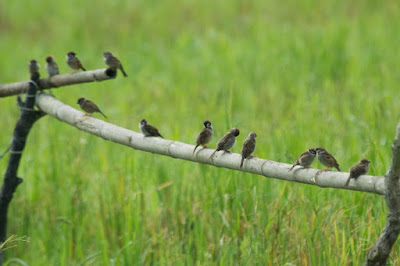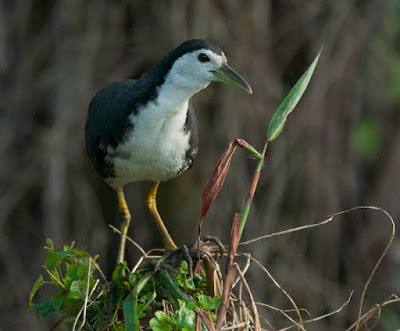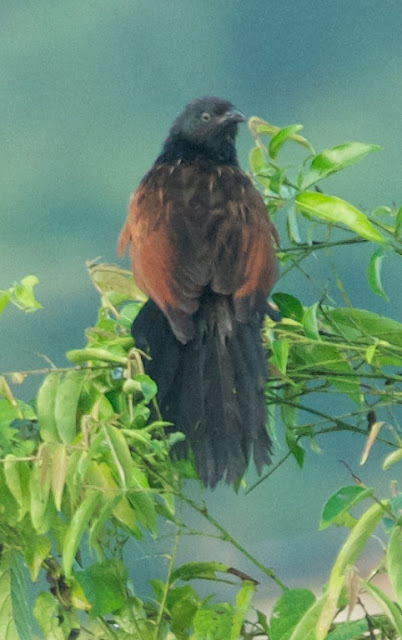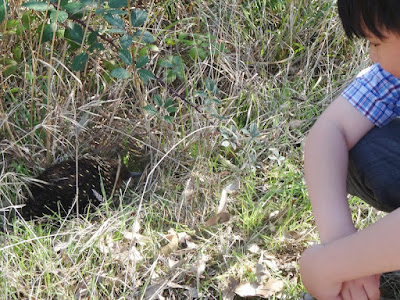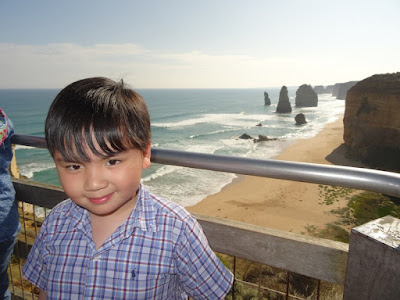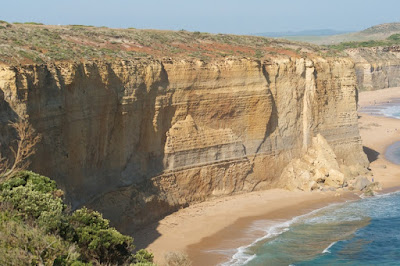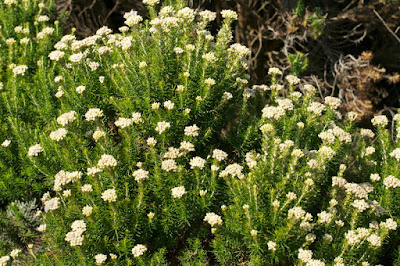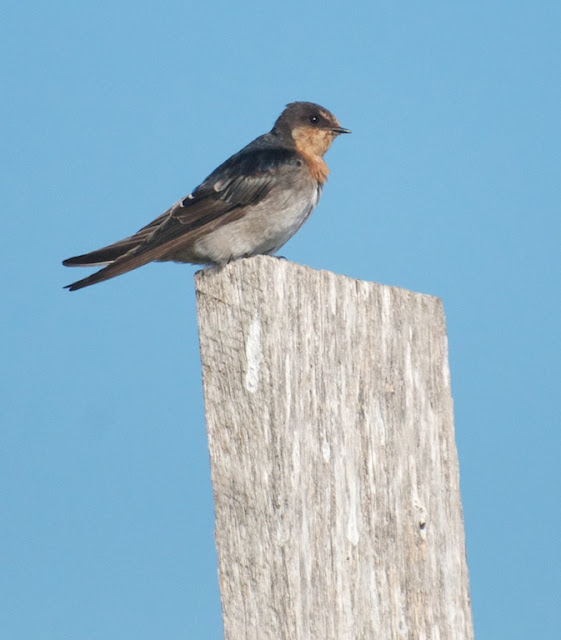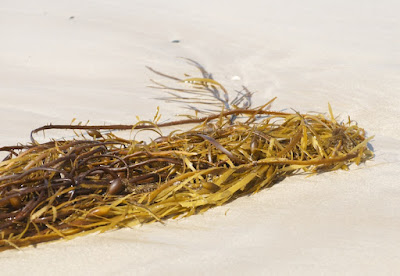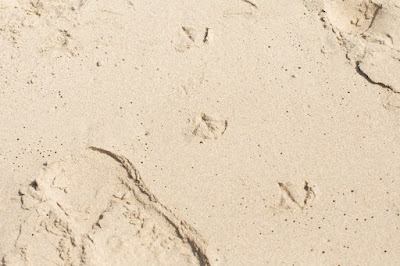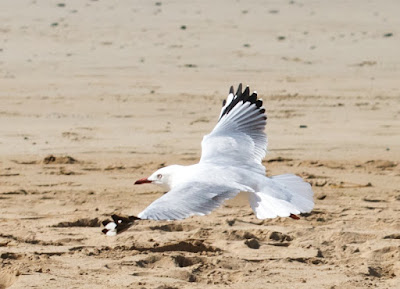Our return to Sarawak, after our two-week trip to Tasmania, was fairly brief. I had to get back to Canada in time to attend a conference in Mexico, so we were mostly busy with packing and goodbyes. I did, though, manage to get in an outing or two - my last in Asia, I thought, for 2014, though (as you will see) Eileen and I were to be back far sooner, and for far longer, than we thought. I didn't know that then, of course, and so I looked at a brief birding trip to Chupak with Vincent Wong, on April 3, 2014, as a sort of farewell.
We didn't see anything all that unusual (which is why I have to resort to a photo of a bunch of Tree Sparrow (Passer montanus) - nice birds though they are).
Nonetheless, it is always nice to get a good look at a Cinnamon Bittern (Ixobrychus cinnamomeus) stalking its prey through the grass.
Closeups of a Common Moorhen (Gallinula chloropus) may not seem all that exciting, but moorhens seem to be a lot shyer here than in, say, a park in London.
White-breasted Waterhens (Amaurornis phoenicurus) are usually much easier to get a close look at. They are practically garden birds in the Kuching area.
At the right times of year, Pacific Golden Plovers (Pluvialis fulva) turn up in areas with shorter vegetation (or, as here, where growing plants are protected by sheets of plastic).
As always, though, the Wood Sandpiper (Tringa glareola) was the commonest of the migrant shorebirds we came across.
For me, the ornithological highlight of the day was a chance to get some more-or-less reasonable photos of a rather ratty-looking Lesser Coucal (Centropus bengalensis). I find these birds harder to come by, or at least to see, than their cousin the Greater Coucal (C. sinensis). Other than size and a very different voice, the best way to spot a Lesser is to look for the pale shaft streaks on its mantle (they show up pretty clearly here).
I also kept an eye out for dragonflies, but got presentable shots of only a couple of common species. This is the near-ubiquitous Neurothemis ramburii.
And here is the commonest and most obvious of the local gomphids, Ictinogomphus decoratus, known as the Common Flangetail in Singapore.
This seems to be the only gomphid to hang around in open marshy areas (as opposed to forest pools and hillside streams), and is pretty much the only one I ever see near Kuching. That, though, says a lot more about my gomphid-finding abilities than it does about the local fauna, as there certainly are a number of other species in the area.
Sunday, February 28, 2016
Wednesday, February 17, 2016
Australia: The Twelve Apostles
The end point on our drive along the Great Ocean Road, on March 29, 2014, was the lookout over one Australia's best-known landmarks: the series of limestone stacks known as the Twelve Apostles. However, before Cho Gek, Paul, Eileen, and Ryan had their chance to pose behind this sign, we had a humbler, but (at least for Ryan and I, the naturalists in the crowd) equally exciting encounter.
Earlier on (see my last post), a group of photographers staring up into tree had led us to a Koala. This time, we came across a group of camera-toting German tourists staring down, into a patch of grass by the roadside. That, to me, suggested that they had found something both interesting and tame, and that meant, in all probability, an echidna. An echidna it was, trundling slowly through the grass, seemingly unconcerned by our presence - a repeat of our previous encounter with its Tasmanian cousin a few days earlier. Ryan was very happy to see it.
The Short-beaked Echidna (Tachyglossus aculeatus) is, of course, an irrestistable creature, perhaps even more so than its cousin the platypus. It's not just that echidnas are cute (though they certainly are). At least for me, it is because they represent a truly ancient lineage.
Though their fossil record only goes back 100 million years or so, they have so many distinct features (not the least that they lay eggs) that they must have branched off the line leading to other living mammals long before that - at least as far back as the middle Jurassic, according to one recent study. That means these little guys, or at least the members of their lineage, have been around for perhaps 165 to 170 million years. Echidnas probably branched away from their platypus cousins as far back as the early Cretaceous. That's impressive.
The echidna having been duly admired, we headed off for the short drive to the Twelve Apostles visitor centre (major tourist attractions always have one of these)....
... and, from there, we walked down to the Apostles themselves.
There are actually only eight apostles left; the ninth collapsed in 2005. A smaller stack nearby collapsed in 2009. Obviously, it is best not to wait if you are planning to go. Apparently the formation was once known as the Sow and Piglets, which, if less evocative, avoided the risk of becoming obsolete as the south coast continues to be eroded by the sea.
By now it was afternoon, and the light was best looking eastward even if the better-known stacks were to the west.
We were not inspired to join the surprising number of visitors who seemed unaware, or unconcerned, about the recent geological history of the place.
On the other hand, maybe the intrepid souls clambering over the rocks in front of us just couldn't read.
There was plenty to see from the lookout without unnecessary risk to life and limb, including the handsomely stratified coastal cliffs.
The coastal scrub behind the cliffs was interesting too - a combination of coarse grasses and densely-packed, salt-resistant heath vegetation.
A convenient sign in the lookout area helped to identify some of the commoner plants.
Pigface (Carpobrotus sp.) scrambles over the clifftops; this may well be a mixture of both native and introduced species, both of which occur in the region.
Coast Everlasting (Ozothamnus turbinatus) grows abundantly here; like other everlastings it is a composite, a member of the daisy family (Asteraceae).
Coast Cushion Bush (Leucophyta browni), another composite, gets its silvery sheen from a coating of woollen hairs. Its fruiting heads, dried and brown during our visit, sport yellowish blooms in the flowering season.
Seaberry Saltbush (Rhagodia candolleana), a member of the goosefoot family or Chenopodiaceae (and sometimes included in the genus Chenopodium), sports berries that look rather like small gummy candies. I gather that they are quite tasty - something I learned after our visit, so I can't speak from personal experience!
By now it was time for us to head back to Melbourne, and to get ready for our flight back to Malaysia the next day. For my final photo from Australia, here is a Welcome Swallow (Hirundo neoxena); I will take its name as an invitation to come back.
Earlier on (see my last post), a group of photographers staring up into tree had led us to a Koala. This time, we came across a group of camera-toting German tourists staring down, into a patch of grass by the roadside. That, to me, suggested that they had found something both interesting and tame, and that meant, in all probability, an echidna. An echidna it was, trundling slowly through the grass, seemingly unconcerned by our presence - a repeat of our previous encounter with its Tasmanian cousin a few days earlier. Ryan was very happy to see it.
The Short-beaked Echidna (Tachyglossus aculeatus) is, of course, an irrestistable creature, perhaps even more so than its cousin the platypus. It's not just that echidnas are cute (though they certainly are). At least for me, it is because they represent a truly ancient lineage.
Though their fossil record only goes back 100 million years or so, they have so many distinct features (not the least that they lay eggs) that they must have branched off the line leading to other living mammals long before that - at least as far back as the middle Jurassic, according to one recent study. That means these little guys, or at least the members of their lineage, have been around for perhaps 165 to 170 million years. Echidnas probably branched away from their platypus cousins as far back as the early Cretaceous. That's impressive.
The echidna having been duly admired, we headed off for the short drive to the Twelve Apostles visitor centre (major tourist attractions always have one of these)....
... and, from there, we walked down to the Apostles themselves.
There are actually only eight apostles left; the ninth collapsed in 2005. A smaller stack nearby collapsed in 2009. Obviously, it is best not to wait if you are planning to go. Apparently the formation was once known as the Sow and Piglets, which, if less evocative, avoided the risk of becoming obsolete as the south coast continues to be eroded by the sea.
By now it was afternoon, and the light was best looking eastward even if the better-known stacks were to the west.
We were not inspired to join the surprising number of visitors who seemed unaware, or unconcerned, about the recent geological history of the place.
On the other hand, maybe the intrepid souls clambering over the rocks in front of us just couldn't read.
There was plenty to see from the lookout without unnecessary risk to life and limb, including the handsomely stratified coastal cliffs.
The coastal scrub behind the cliffs was interesting too - a combination of coarse grasses and densely-packed, salt-resistant heath vegetation.
A convenient sign in the lookout area helped to identify some of the commoner plants.
Pigface (Carpobrotus sp.) scrambles over the clifftops; this may well be a mixture of both native and introduced species, both of which occur in the region.
Coast Everlasting (Ozothamnus turbinatus) grows abundantly here; like other everlastings it is a composite, a member of the daisy family (Asteraceae).
Coast Cushion Bush (Leucophyta browni), another composite, gets its silvery sheen from a coating of woollen hairs. Its fruiting heads, dried and brown during our visit, sport yellowish blooms in the flowering season.
Seaberry Saltbush (Rhagodia candolleana), a member of the goosefoot family or Chenopodiaceae (and sometimes included in the genus Chenopodium), sports berries that look rather like small gummy candies. I gather that they are quite tasty - something I learned after our visit, so I can't speak from personal experience!
By now it was time for us to head back to Melbourne, and to get ready for our flight back to Malaysia the next day. For my final photo from Australia, here is a Welcome Swallow (Hirundo neoxena); I will take its name as an invitation to come back.
Labels:
Australia
Location:
The Twelve Apostles, Victoria, Australia
Thursday, February 4, 2016
Australia: Great Ocean Road
For our last full day in Australia - March 29, 2014 - our friends Paul Pui and his wife Cho Gek Tan had a special treat for us: a drive southwest of Melbourne along the Great Ocean Road, perhaps Australia's most famous scenic route. The day deserves more than one post; this is the first of two.
Our first stop, at Point Addis, was a bit of a detour, but I had talked everyone into it in the hope of turning up a local specialty, the Rufous Bristlebird (Dasyornis broadbenti), which occasionally prances about the parking lot. Of course, it failed to do so when we were there. Nonetheless, the point provided us with some lovely views of coastal heath and oceanfront scenery.
At the seaward edge of the heath, where their thickened leaves can resist the salt spray from the nearby coast, sprawling clumps of Pigface (Carpobrotus sp.) cover the ground. Without flowers it is difficult to tell which species is involved: pigfaces of different types, both native and introduced, may grow together here.
Further inland, away from the spray, dense heathland vegetation dominates the landscape.
One of the heathland species is Scented Paperbark (Melaleuca squarrosa), its small leaves and dense growth typical of this sort of vegetation.
Ryan was much more interested in the beach itself (as any small boy would be).
Time to move on!
From Point Addis we returned to the main road, and headed off to the southwest. As we drove, the road began to follow the coast more closely. At one point we stopped to let Ryan and Paul climb down to the beach to check out a series of rockpools.
Here, the beach wrack included numbers of cuttlebones - cuttlefish must be abundant in the offshore waters. Notice the pale white shell of a ghost crab in the lower photograph.
At one point I found the carcass of a shearwater on the sand. I didn't check it carefully enough to be sure, but I suspect that this was once a Short-tailed Shearwater (Ardenna tenuirostris), a bird that breeds in huge numbers in Bass Strait.
Paul and Ryan, meanwhile, were checking out the rockpools (or tide pools, as we call them in North America).
Neptune's Necklace (Hormosira banksii), one of the more distinctive seaweeds, was as prominent here as in the rockpools we had visited in Tasmania.
Among the Neptune's Necklaces we found a variety of rock-loving mollusks, including Black Nerite (Nerita atramentosa) and Zebra Top Shell (Austrocochlea porcata).
Here are more nerites and top shells, surrounding an Orange-edged Limpet (Cellana solida).
Nerites of various sorts are common rock-pool snails in many of the warmer parts of the world, where they spend their time grazing on algae. I remember as a hold exploring tide pools in Jamaica encrusted with Bleeding-tooth Nerites (Nerita peloronta) - so-called because of the orange-stained, serrated edge to the shell opening, visible when you turn the shell over. The Black Nerite appears, indeed, to be entirely black, but the interior of its shell is white. It is found around much the Australian coastline, from Queensland southward to Tasmania and westward to Western Australia.
Further along the coast, the road rises along the tops of the sea cliffs, giving spectacular views of rocky, wave-spattered islets just offshore.
The view is particularly impressive from the Cape Patton Lookout, the high point on this part of the drive.
From here, the road drops down to parallel a series of sandy beaches - ideal places, once again, for inquisitive little boys.
The beaches are also good places for signing your name.
While Ryan wrote on the sand, I investigated the beach wrack - mostly clumps of Strap Weed (Phyllospora comosa).
This Pink Tellin (Tellina albinella) was another reminder of my youthful beach walks on the north coast of Jamaica (in the late 1950s!), except there the common species was the Sunrise Tellin (T. radiata). Tellins burrow into the sands just offshore - sometimes as much as a foot down - and their dead valves are common on tropical and warm-temperate beaches (where they are very popular with shell-craft makers, and it is easy to see why).
Other beachcombers than ourselves betrayed themselves by their tracks..
...or waited for us in person. These are Silver Gulls (Chroicocephalus novaehollandiae), the common gull over most of Australia.
Common though they are, they are highly attractive and, like all gulls, fun to watch as they go about their business.
Little groups clustered around picnickers on the beach, hoping for handouts (as gulls do everywhere...)
Ryan was not about to disappoint them (though I am not sure what he is offering them here).
On we drove, through a bit of coastal woodland - where I noticed a few photographers looking steadfastly up into a eucalyptus tree. That, in this part of Australia, likely meant only one thing - and for that, we definitely had to stop....
...and there it was, sitting placidly over our heads: Australia's quintessential animal, a Koala (Phascolarctos cinereus). In this shot it is showing off its unusual hind foot: notice that the big toe has no claw at all, but the second toe appears to be equipped with two. In fact what you are seeing are the second and third toes, which are fused together. Their two claws provide the Koala with a handy grooming comb (also useful for removing ticks).
There is a large population of Koalas in the coastal bushland along the Otway Coast section of the Great Ocean Road, one of the best places to to see one - still, a Koala encounter in the wild is a memorable experience, even if the animals themselves - lethargic creatures by day - don't actually do very much other than look back at you, or doze peacefully in the sun.
Our first stop, at Point Addis, was a bit of a detour, but I had talked everyone into it in the hope of turning up a local specialty, the Rufous Bristlebird (Dasyornis broadbenti), which occasionally prances about the parking lot. Of course, it failed to do so when we were there. Nonetheless, the point provided us with some lovely views of coastal heath and oceanfront scenery.
At the seaward edge of the heath, where their thickened leaves can resist the salt spray from the nearby coast, sprawling clumps of Pigface (Carpobrotus sp.) cover the ground. Without flowers it is difficult to tell which species is involved: pigfaces of different types, both native and introduced, may grow together here.
Further inland, away from the spray, dense heathland vegetation dominates the landscape.
One of the heathland species is Scented Paperbark (Melaleuca squarrosa), its small leaves and dense growth typical of this sort of vegetation.
Ryan was much more interested in the beach itself (as any small boy would be).
Time to move on!
From Point Addis we returned to the main road, and headed off to the southwest. As we drove, the road began to follow the coast more closely. At one point we stopped to let Ryan and Paul climb down to the beach to check out a series of rockpools.
Here, the beach wrack included numbers of cuttlebones - cuttlefish must be abundant in the offshore waters. Notice the pale white shell of a ghost crab in the lower photograph.
At one point I found the carcass of a shearwater on the sand. I didn't check it carefully enough to be sure, but I suspect that this was once a Short-tailed Shearwater (Ardenna tenuirostris), a bird that breeds in huge numbers in Bass Strait.
Paul and Ryan, meanwhile, were checking out the rockpools (or tide pools, as we call them in North America).
Neptune's Necklace (Hormosira banksii), one of the more distinctive seaweeds, was as prominent here as in the rockpools we had visited in Tasmania.
Among the Neptune's Necklaces we found a variety of rock-loving mollusks, including Black Nerite (Nerita atramentosa) and Zebra Top Shell (Austrocochlea porcata).
Here are more nerites and top shells, surrounding an Orange-edged Limpet (Cellana solida).
Nerites of various sorts are common rock-pool snails in many of the warmer parts of the world, where they spend their time grazing on algae. I remember as a hold exploring tide pools in Jamaica encrusted with Bleeding-tooth Nerites (Nerita peloronta) - so-called because of the orange-stained, serrated edge to the shell opening, visible when you turn the shell over. The Black Nerite appears, indeed, to be entirely black, but the interior of its shell is white. It is found around much the Australian coastline, from Queensland southward to Tasmania and westward to Western Australia.
Further along the coast, the road rises along the tops of the sea cliffs, giving spectacular views of rocky, wave-spattered islets just offshore.
The view is particularly impressive from the Cape Patton Lookout, the high point on this part of the drive.
From here, the road drops down to parallel a series of sandy beaches - ideal places, once again, for inquisitive little boys.
The beaches are also good places for signing your name.
While Ryan wrote on the sand, I investigated the beach wrack - mostly clumps of Strap Weed (Phyllospora comosa).
This Pink Tellin (Tellina albinella) was another reminder of my youthful beach walks on the north coast of Jamaica (in the late 1950s!), except there the common species was the Sunrise Tellin (T. radiata). Tellins burrow into the sands just offshore - sometimes as much as a foot down - and their dead valves are common on tropical and warm-temperate beaches (where they are very popular with shell-craft makers, and it is easy to see why).
Other beachcombers than ourselves betrayed themselves by their tracks..
...or waited for us in person. These are Silver Gulls (Chroicocephalus novaehollandiae), the common gull over most of Australia.
Common though they are, they are highly attractive and, like all gulls, fun to watch as they go about their business.
Little groups clustered around picnickers on the beach, hoping for handouts (as gulls do everywhere...)
Ryan was not about to disappoint them (though I am not sure what he is offering them here).
On we drove, through a bit of coastal woodland - where I noticed a few photographers looking steadfastly up into a eucalyptus tree. That, in this part of Australia, likely meant only one thing - and for that, we definitely had to stop....
...and there it was, sitting placidly over our heads: Australia's quintessential animal, a Koala (Phascolarctos cinereus). In this shot it is showing off its unusual hind foot: notice that the big toe has no claw at all, but the second toe appears to be equipped with two. In fact what you are seeing are the second and third toes, which are fused together. Their two claws provide the Koala with a handy grooming comb (also useful for removing ticks).
There is a large population of Koalas in the coastal bushland along the Otway Coast section of the Great Ocean Road, one of the best places to to see one - still, a Koala encounter in the wild is a memorable experience, even if the animals themselves - lethargic creatures by day - don't actually do very much other than look back at you, or doze peacefully in the sun.
Labels:
Australia
Location:
Lorne VIC 3232, Australia
Subscribe to:
Comments (Atom)


